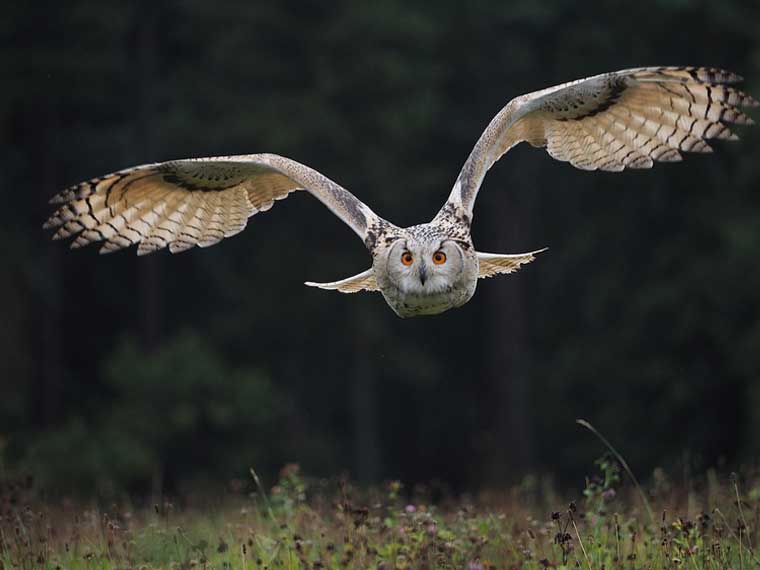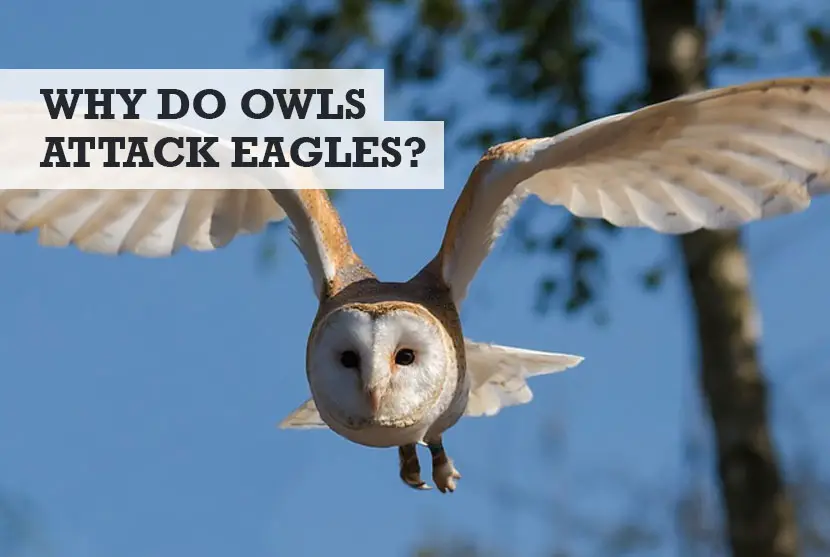Last week I am convinced that I saw an owl attack an eagle over the woods to the rear of the property. Given that eagles are apex predators, I couldn’t believe my eyes, so asked the experts do owls and eagles fight, and if so, what the outcome would be. Here’s what I learned.
Why do owls attack eagles? Smaller birds have been seen to attack and harass predatory birds such as eagles. A first response to the question of why owls attack eagles is to pass it off as harassment of a dangerous neighbor.
However, it is a lot more complex than this. Both owls and eagles are raptors, species of birds that hunt and eat meat. They share 3 characteristics: 8 sharp talons, keen eyesight that sees forward, and a hooked beak.
Both owls and eagles are apex predators, top hunters, in the bird kingdom, and their ranges overlap in several parts of the world.
That sharing of territory inevitably leads to conflicts.

Those conflicts play out differently, depending on the relative strengths of each specie. An excellent example of how these conflicts occur is the never-ending battle between the great horned owl and the bald eagle.
The bald eagle (Haliaeetus leucocephalus) is a large, strong predator, one of the largest birds in North America. It can weigh as much as 14 lbs and can carry 2 or 3 lbs for a short distance.
An eagle has a wingspan of as much as 200 cm (60 in). A large and intimidating bird, bald eagles often steal food from smaller birds, like hawks and ospreys. Their favorite food is fish, especially rich, fatty salmon, but they also eat smaller birds and mammals, and carrion.
Bald eagles prefer to nest in treetops, building large, strong nests of sticks and softer materials like grass or moss. In areas where tall strong trees are unavailable, they will build their nest in a rocky crevice, or even on the ground. Nests take as much as 3 months to build, with the both partners gathering materials but the female doing most of the placement.
Great horned owls (Bubo virginianus) are much smaller, weighing 2 to 5 lbs with a wingspan of 100 to 150 cm. Although only 1/3 the size of a bald eagle, great horned owls have some advantages. They have a more powerful grip. They are able to exert up to 28 lbs of pressure with their talons.
That powerful grip allows them to break the spine of large prey. Their soft-edged feathers allow them to fly nearly soundlessly, and their short wingspan allows them to maneuver through trees.
They have superior eyesight. Their large eyes and ability to rotate their head to see behind them gives them a full range of vision, even at night. This package makes the great horned owl a formidable foe, even for the much larger bald eagle.
So, now you know the statistics between these two great warriors, here’s more about whether an owl can eat an eagle and who might win the fight.
Fights between bald eagles and great horned owls
Generally, raptors avoid conflict with another top bird of prey. When conflict occurs, it is usually over either food or nesting. Conflict can occur when a bald eagle steals food from a great horned owl. Eagles often take food from other, smaller predators, including hawks and ospreys, and mammals like wolves.
However, the small size of the owl’s prey, combined with the ferocity of the owl’s response, tends to limit the incidents of eagles stealing from owls.
Why do great horned owls attack bald eagles?
A more common cause of conflict is nesting needs. Great horned owls rarely build their own nests, instead preferring to use an abandoned nest built by another specie. When owls find an unattended nest with chicks, they have an opportunity to acquire both a nest and a first meal.
So, a bald eagle, returning to the nest, may find her chicks eaten and her home occupied by a great horned owl. The eagles rarely retaliate as the battle is hazardous and the nest is already unneeded since the chicks are dead.
Since the owls now possess the nest, they will lay eggs and vigorously defend their nest against all intruders.
So, bald eagles occasionally attack great horned owls to steal their food, and great horned owls occasionally steal nests from angry bald eagles.
However, both seem to prefer to avoid direct conflict as they are too evenly matched. Most likely, when an owl is observed attacking a bald eagle, the owl is defending its nest. Owls rarely lose these conflicts as they are very noisy and persistent.
Other owls worldwide
Owls have such a distinctive look, with their large heads and large, forward-facing eyes, that they are immediately recognized worldwide. Their large eyes and face shape give them acute hearing and vision. They have a sharp, downward angled beak that allows them to rend their prey easily, similar to other birds of prey. Their soft feathers allow them to fly almost soundlessly, so their prey does hear them coming.
Owls eat all of their prey, often whole, then regurgitate pellets of the bones, feathers, and fur. These unique abilities and characteristics set them apart of other raptors.
While all owls share those characteristics, they also differ greatly. Owls are classified into 2 types, Strigidae or typical owls, and Tytonidae, or barn owls. Barn owls have smaller eyes for their size, a longer beak, and a heart-shaped facial disk.
Those characteristics give them advantages in hunting their chosen prey, usually small birds and rodents. Owls range in size from the Least Pygmy Owl that is only 12 cms tall to the Eurasian Eagle Owl that can be as much as 71 cms tall. Owls are found on every continent except Antarctica.
Eagles worldwide
Like owls, eagles are found throughout much of the world, except Antarctica. Eagles, order Accipitriformes, are big footed and heavy beaked, with a large wingspan for their size. Eagles are larger than buteos but smaller than vultures.
They are predators, eating a range of other birds, fish, and small to medium mammals, depending on the breed of eagle. With a wide wingspan and acute eyesight, eagles often hunt from a distance, soaring high into the sky with their powerful wings and ability to glide, then dive rapidly at prey spotted below. Eagles will also eat carrion or steal a kill from other animals.
Both eagles and owls have evolved to be very efficient hunters. While both are predators, their physiology has led them toward very different hunting styles. Those differences limit their daily interactions.
Where can I see eagles and owls in the wild?
Wildlife research organizations throughout North America and Europe offer tours online and in person. An excellent example is the Raptor Center at the University of Minnesota. Extensive raptor watching tours are also available in Africa, allowing the opportunity to journey into the wilds to see raptors in their natural environment.
Are eagles an endangered species?
The populations of many breeds of eagles have declined in recent years due to loss of habitat. Eagle breeds throughout Africa, for example, are declining, with populations of larger eagles especially endangered.
There is good news, however. Bald eagles are no longer endangered. Fifty years ago, the use of the pesticide DDT caused the shells of bald eagle eggs to become thin and fragile. Their population plummeted as Few chicks survived to hatching.
Changes in laws prohibited the use of DDT in the United States, and populations slowly recovered. Bald eagles were removed from the Endangered Species List in 2007. They continue to enjoy some protection, however from the Bald and Golden Eagle Protection Act. The recovery of the bald eagle reminds us that we can help these species survive.
Conclusion
It seems like I might be right, and owls do hate eagles enough to attack them when territory, food, and the safety of their chicks is compromised!
You might also like…
- How much bald eagles are worth will shock you
- How much a bald eagle can lift and carry off
- How high bald eagles are known to build their nests
Image of an owl attacking an eagle in the header via https://pixabay.com/photos/barn-owl-bird-flying-wings-owl-1107397/


